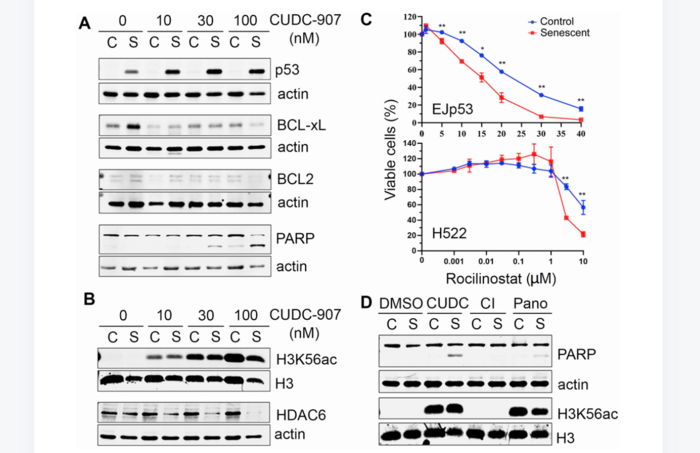“The mechanisms of induction of senescent cell death by CUDC-907 remain to be fully elucidated.”

Credit: 2023 Al-Mansour et al.
“The mechanisms of induction of senescent cell death by CUDC-907 remain to be fully elucidated.”
BUFFALO, NY- April 25, 2023 – A new research paper was published in Aging (listed by MEDLINE/PubMed as “Aging (Albany NY)” and “Aging-US” by Web of Science) Volume 15, Issue 7, entitled, “Characterization of the HDAC/PI3K inhibitor CUDC-907 as a novel senolytic.”
The accumulation of senescent cells has an important role in the phenotypical changes observed in aging and in many age-related pathologies. Thus, the strategies designed to prevent these effects, collectively known as senotherapies, have a strong clinical potential.
Senolytics are a type of senotherapy aimed at specifically eliminating senescent cells from tissues. Several small molecule compounds with senolytic properties have already been identified, but their specificity and range of action are variable. Because of this, potential novel senolytics are being actively investigated.
Given the involvement of HDACs and the PI3K pathway in senescence, researchers Fares Al-Mansour, Abdullah Alraddadi, Buwei He, Anes Saleh, Marta Poblocka, Wael Alzahrani, Shaun Cowley, and Salvador Macip from the University of Leicester, Najran University and Universitat Oberta de Catalunya hypothesized that the dual inhibitor CUDC-907, a drug already in clinical trials for its antineoplastic effects, could have senolytic effects.
“Here, we show that CUDC-907 was indeed able to selectively induce apoptosis in cells driven to senesce by p53 expression, but not when senescence happened in the absence of p53.”
Consistent with this, CUDC-907 showed senolytic properties in different models of stress-induced senescence. Their results also indicate that the senolytic functions of CUDC-907 depend on the inhibitory effects of both HDACs and PI3K, which leads to an increase in p53 and a reduction in BH3 pro-survival proteins. Taken together, their results show that CUDC-907 has the potential to be a clinically relevant senolytic in pathological conditions in which stress-induced senescence is involved.
“According to our results, CUDC-907 could be an interesting drug to be used as a senolytic, alone or as part of a targeted approach.”
Continue Reading: DOI: https://doi.org/10.18632/aging.204616
Corresponding Author: Salvador Macip
Corresponding Email: [email protected]
Keywords: senescence, senolytics, HDAC, PI3K, CUDC-907
Sign up for free Altmetric alerts about this article: https://aging.altmetric.com/details/email_updates?id=10.18632%2Faging.204616
About Aging-US:
Launched in 2009, Aging publishes papers of general interest and biological significance in all fields of aging research and age-related diseases, including cancer—and now, with a special focus on COVID-19 vulnerability as an age-dependent syndrome. Topics in Aging go beyond traditional gerontology, including, but not limited to, cellular and molecular biology, human age-related diseases, pathology in model organisms, signal transduction pathways (e.g., p53, sirtuins, and PI-3K/AKT/mTOR, among others), and approaches to modulating these signaling pathways.
Please visit our website at www.Aging-US.com and connect with us:
- SoundCloud
- YouTube
- LabTube
Click here to subscribe to Aging publication updates.
For media inquiries, please contact [email protected].
Aging (Aging-US) Journal Office
6666 E. Quaker Str., Suite 1B
Orchard Park, NY 14127
Phone: 1-800-922-0957, option 1
###
Journal
Aging-US
DOI
10.18632/aging.204616
Method of Research
Experimental study
Subject of Research
Cells
Article Title
Characterization of the HDAC/PI3K inhibitor CUDC-907 as a novel senolytic
Article Publication Date
28-Mar-2023




